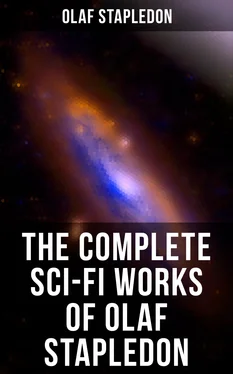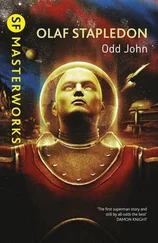Olaf Stapledon - The Complete Sci-Fi Works of Olaf Stapledon
Здесь есть возможность читать онлайн «Olaf Stapledon - The Complete Sci-Fi Works of Olaf Stapledon» — ознакомительный отрывок электронной книги совершенно бесплатно, а после прочтения отрывка купить полную версию. В некоторых случаях можно слушать аудио, скачать через торрент в формате fb2 и присутствует краткое содержание. Жанр: unrecognised, на английском языке. Описание произведения, (предисловие) а так же отзывы посетителей доступны на портале библиотеки ЛибКат.
- Название:The Complete Sci-Fi Works of Olaf Stapledon
- Автор:
- Жанр:
- Год:неизвестен
- ISBN:нет данных
- Рейтинг книги:5 / 5. Голосов: 1
-
Избранное:Добавить в избранное
- Отзывы:
-
Ваша оценка:
- 100
- 1
- 2
- 3
- 4
- 5
The Complete Sci-Fi Works of Olaf Stapledon: краткое содержание, описание и аннотация
Предлагаем к чтению аннотацию, описание, краткое содержание или предисловие (зависит от того, что написал сам автор книги «The Complete Sci-Fi Works of Olaf Stapledon»). Если вы не нашли необходимую информацию о книге — напишите в комментариях, мы постараемся отыскать её.
Novels:
Last and First Men: A Story of the Near and Far Future
Last Men in London
Odd John: A Story Between Jest and Earnest
Star Maker
Darkness and the Light
Sirius: A Fantasy of Love and Discord
Death into Life
Short Stories:
The Flames (1947)
The Seed and the Flower
The Road to the Aide Post
A Modern Magician
East is West
A World of Sounds
Arms Out of Hand
The Complete Sci-Fi Works of Olaf Stapledon — читать онлайн ознакомительный отрывок
Ниже представлен текст книги, разбитый по страницам. Система сохранения места последней прочитанной страницы, позволяет с удобством читать онлайн бесплатно книгу «The Complete Sci-Fi Works of Olaf Stapledon», без необходимости каждый раз заново искать на чём Вы остановились. Поставьте закладку, и сможете в любой момент перейти на страницу, на которой закончили чтение.
Интервал:
Закладка:
This discovery was a tonic to a melancholy race. Men turned from the tragic past to the bewildering present and the uncertain future.
For it was evident that, if the present acceleration of approach were to be maintained, the moon would enter the critical zone and disintegrate in less than ten million years; and, further, that the fragments would not maintain themselves as a ring, but would soon crash upon the earth. Heat generated by their impact would make the surface of the earth impossible as the home of life. A short-lived and short-sighted species might well have considered ten million years as equivalent to eternity. Not so the Fifth Men. Thinking primarily in terms of the race, they recognized at once that their whole social policy must now be dominated by this future catastrophe. Some there were indeed who at first refused to take the matter seriously, saying that there was no reason to believe that the moon’s odd behaviour would continue indefinitely. But as the years advanced, this view became increasingly improbable. Some of those who had spent much of their lives in exploration of the past now sought to explore the future also, hoping to prove that human civilization would always be discoverable on the earth in no matter how remote a future. But the attempt to unveil the future by direct inspection failed completely. It was surmised, erroneously, that future events, unlike past events, must be strictly non-existent until their creation by the advancing present.
Clearly humanity must leave its native planet. Research was therefore concentrated on the possibility of flight through empty space, and the suitability of neighbouring worlds. The only alternatives were Mars and Venus. The former was by now without water and without atmosphere. The latter had a dense moist atmosphere, but one which lacked oxygen. The surface of Venus, moreover, was known to be almost completely covered with a shallow ocean. Further the planet was so hot by day that, even at the poles, man in his present state would scarcely survive.
It did not take the Fifth Men many centuries to devise a tolerable means of voyaging in interplanetary space. Immense rockets were constructed, the motive power of which was derived from the annihilation of matter. The vehicle was propelled simply by the terrific pressure of radiation thus produced. ‘Fuel’ for a voyage of many months, or even years, could, of course, easily be carried, since the annihilation of a minute amount of matter produced a vast wealth of energy. Moreover, when once the vessel had emerged from the earth’s atmosphere, and had attained full speed, she would, of course, maintain it without the use of power from the rocket apparatus. The task of rendering the ‘ether-ship’ properly manageable and decently habitable proved difficult, but not insurmountable. The first vessel to take the ether was a cigar-shaped hull some three thousand feet long, and built of metals whose artificial atoms were incomparably more rigid than anything hitherto known. Batteries of ‘rocket’ apparatus at various points on the hull enabled the ship not only to travel forward, but to reverse, turn in any direction, or side-step. Windows of an artificial transparent element, scarcely less strong than the metal of the hull, enabled the voyagers to look around them. Within there was ample accommodation for a hundred persons and their provisions for three years. Air for the same period was manufactured in transit from protons and electrons stored under pressure comparable to that in the interior of a star. Heat was, of course, provided by the annihilation of matter. Powerful refrigeration would permit the vessel to approach the sun almost to the orbit of Mercury. An ‘artificial gravity’ system, based on the properties of the electro-magnetic field, could be turned on and regulated at will, so as to maintain a more or less normal environment for the human organism.
This pioneer ship was manned with a navigating crew and a company of scientists, and was successfully dispatched upon a trial trip. The intention was to approach close to the surface of the moon, possibly to circumnavigate it at an altitude of ten thousand feet, and to return without landing. For many days those on earth received radio messages from the vessel’s powerful installation, reporting that all was going well. But suddenly the messages ceased, and no more was ever heard of the vessel. Almost at the moment of the last message, telescopes had revealed a sudden flash of light at a point on the vessel’s course. It was therefore surmised that she had collided with a meteor and fused with the heat of the impact.
Other vessels were built and dispatched on trial voyages. Many failed to return. Some got out of control, and reported that they were heading for outer space or plunging towards the sun, their hopeless messages continuing until the last of the crew succumbed to suffocation. Other vessels returned successfully, but with crews haggard and distraught from long confinement in bad atmosphere. One, venturing to land on the moon, broke her back, so that the air rushed out of her, and her people died. After her last message was received, she was detected from the earth, as an added speck on the stippled surface of a lunar ‘sea’.
As time passed, however, accidents became rarer; indeed, so rare that trips in the void began to be a popular form of amusement. Literature of the period reverberates with the novelty of such experiences, with the sense that man had at last learned true flight, and acquired the freedom of the solar system. Writers dwelt upon the shock of seeing, as the vessel soared and accelerated, the landscape dwindle to a mere illuminated disc or crescent, surrounded by constellations. They remarked also the awful remoteness and mystery which travellers experienced on these early voyages, with dazzling sunlight on one side of the vessel and dazzlingly bespangled night on the other. They described how the intense sun spread his corona against a black and star-crowded sky. They expatiated also on the overwhelming interest of approaching another planet; of inspecting from the sky the still visible remains of Martian civilization; of groping through the cloud banks of Venus to discover islands in her almost coastless ocean; of daring an approach to Mercury, till the heat became insupportable in spite of the best refrigerating mechanism; of feeling a way across the belt of the asteroids and onwards toward Jupiter, till shortage of air and provisions forced a return.
But though the mere navigation of space was thus easily accomplished, the major task was still untouched. It was necessary either to remake man’s nature to suit another planet, or to modify conditions upon another planet to suit man’s nature. The former alternative was repugnant to the Fifth Men. Obviously it would entail an almost complete refashioning of the human organism. No existing individual could possibly be so altered as to live in the present conditions of Mars or Venus. And it would probably prove impossible to create a new being, adapted to these conditions, without sacrificing the brilliant and harmonious constitution of the extant species.
On the other hand, Mars could not be made habitable without first being stocked, with air and water; and such an undertaking seemed impossible. There was nothing for it, then, but to attack Venus. The polar surfaces of that planet, shielded by impenetrable depths of cloud, proved after all not unendurably hot. Subsequent generations might perhaps be modified so as to withstand even the sub-arctic and ‘temperate’ climates. Oxygen was plentiful, but it was all tied up in chemical combination. Inevitably so, since oxygen combines very readily, and on Venus there was no vegetable life to exhale the free gas and replenish the ever-vanishing supply. It was necessary, then, to equip Venus with an appropriate vegetation, which in the course of ages should render the planet’s atmosphere hospitable to man. The chemical and physical conditions on Venus had therefore to be studied in great detail, so that it might be possible to design a kind of life which would have a chance of flourishing. This research had to be carried out from within the ether-ships, or with gas helmets, since no human being could live in the natural atmosphere of the planet.
Читать дальшеИнтервал:
Закладка:
Похожие книги на «The Complete Sci-Fi Works of Olaf Stapledon»
Представляем Вашему вниманию похожие книги на «The Complete Sci-Fi Works of Olaf Stapledon» списком для выбора. Мы отобрали схожую по названию и смыслу литературу в надежде предоставить читателям больше вариантов отыскать новые, интересные, ещё непрочитанные произведения.
Обсуждение, отзывы о книге «The Complete Sci-Fi Works of Olaf Stapledon» и просто собственные мнения читателей. Оставьте ваши комментарии, напишите, что Вы думаете о произведении, его смысле или главных героях. Укажите что конкретно понравилось, а что нет, и почему Вы так считаете.












